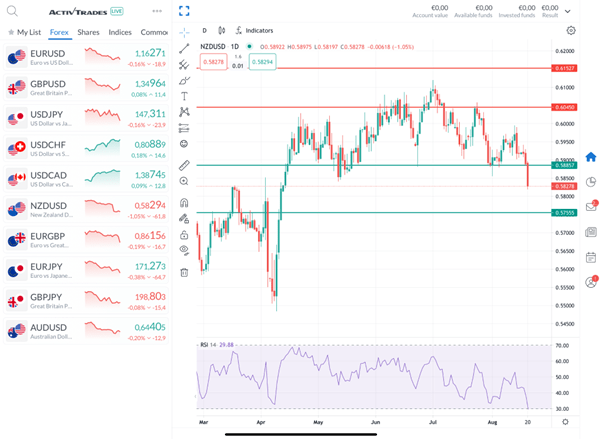
The following is a version of Carolane De Palmas, a shopping analyzer at Retail FX and CFDS Broker Activetrades.
A year ago, New Zealand’s official cash rate (OCR) was 5.5%. Since then, the New Zealand Bank (RBNZ) has rotated abruptly, reducing rates by reducing inflation falling and the weakening of the labor market. Today’s decision to reduce OCR by 25 basis points, bringing it to 3%, highlights RBNZ’s focus on attaching the economy against soft domestic demand and global uncertainty. NZD lost more than 1% against USD after RBNZ decision, pushing NZD/USD into territory.

Daily NZD/USD diagram – Source: Activtrades
The central bank remains careful, balancing the risk of doing too little to support growth with the risk of loosening policy very quickly, while inflation is still close to the top of the target band. How far and how fast the relaxation cycle continues will depend on the pace of New Zealand recovery in the coming months. Let’s take a closer look.
Inflation: a temporary hit on a downward route
Head inflation CPI remains close to the upper end of the 1-3% target zone at 2.7% during the quarter of June (after 2.5% during the quarter of March), but underlying pressures relax as domestic demand softens and built in the economy. RBNZ expects inflation to gradually decline, converge to 2 % in the middle of the point by mid -2026.
However, in the short term, however, the prospects are complicated by the projected increase in annual inflation to about 3.0 % in the September quarter – possibly violating the target ceiling. The Commission emphasizes that this spike reflects the provisional factors and occurs very soon for monetary policy to substantially affect.
If inflation will remain higher for a longer period of time, expectations could become non -markets by supplying wage and prices. At present, however, the Central Bank considers that inflation is widely under control of the forecast.
Growth: Recovery stables under global tariff pressure
While inflation relaxes, growth has been significantly weakened. The RBNZ estimates that GDP has shrunk by 0.3 % in June 2025, after moderate profits in December 2024 and March 2025. High frequency indicators indicate hypotheous household costs, limited business investment and lifting activity. Employment has softened, and the increased prices for the essentials are still pushing real incomes.
The export sector has provided some relief, enhanced by the prices of strong dairy products, meat and vegetables. However, recovery is heterogeneous: areas associated with domestic demand remain under pressure and global uncertainty launch a long shade. Commercial restrictions and invoices – especially from the United States – face new risk. The effective invoices of New Zealand exports to the US is now higher than expected, threatening more difficult conditions for exporters. Although the short -term demand for the US import before the implementation of duties temporarily reinforced the exports of goods earlier this year, the medium -term orbit is extremely uncertain.
At present, the New Zealand Central Bank undertakes that the slowdown in June partly reflects temporary factors such as the lower export volumes after prior force. Growth is expected to continue in the September quarter, backed by lower interest rates and stabilizing global conditions. However, the balance of the risk is sloping down, with invoices, weaker transactions growth and fragile domestic demand weighing all prospects.
Residential Purchase: A weak link to recovery
The housing remains central to New Zealand’s financial prospects, not only as a domestic construction guide but also as a key element of the wealth of households and consumer confidence. However, despite easier economic conditions and political support, the sector has struggled to create a significant impulse in 2025.
According to WestPac’s July home market, housing sales increased by about 17 % annually, reflecting the strongest activity under lower interest rates. However, prices have been delayed, increasing by just 1 percent in the first half of 2025. While demand has been improved, it was heterogeneous and relatively silent. At the same time, the offer responded more than expected, increasing the upward pressure on prices.
Several structural agents weigh in housing demand. The rents have softened, with new rental agreements operating at a negative annual interest rate, signaling weak underlying demand. Pure migration remains below average, limiting housing pressure on the population. In addition, concerns about global growth and wider domestic economic weakness contribute to attention among future buyers.
For RBNZ, the insistence on the inability to market housing is remarkable because this sector is particularly sensitive to interest rates and usually among the first to respond to monetary relaxation. However, despite several rounds of cuts, residential constructions, housing turnover and retail activity linked to the wealth of housing have not shown the type of recovery that is usually expected at this stage of the cycle. This suggests that the transmission of monetary policy to household balance sheets and expenses occurs more slowly than usual.
What to expect then from rbnz now
Reserve Bank has made it clear that the relaxation cycle has not yet been completed. Since August 2024, the Monetary Policy Committee has steadily reduced the official cash rate, as inflation pressures have been reduced and reserve capacity has arisen in the economy. Private consumption was widely responded to expectations, but housing investments-formally one of the most sensitive interest rates-were weaker than expected, closely linked to the slow rise in housing prices.
Both RBNZ and market economists expect further cuts in the following quarters. The central bank promotes the OCR to decrease to a lower level than previously allegedly reflecting the softer GDP growth, sluggish demand and the need to ensure that inflation will attribute to 2 % in the middle of the point. Economists, meanwhile, see the danger that RBnz may need to go beyond its own forecasts. Anz chief economist Sharon Zollner, for example, recently brought out its call for two additional cuts in October and November, citing weak domestic momentum and growing global risks.
While inflation can briefly touch the upper edge of the zone 1-3 % later this year, the medium-term orbit is down. In this context of the sluggish development, the weak demand for housing and the global uncertainty of trade, the balance of risks continues to lean towards more monetary support. RBNZ’s message is clear: The lower interest rates remain the main lever to stabilize the activity and to ensure the installation of inflation comfortably in the target in the medium term.
Sources: Wall Street Journal, RBNZ, Westpac
The information provided does not constitute investment research. The material has not been prepared in accordance with the legal requirements aimed at promoting the independence of investment research and therefore must be regarded as marketing communication.
All information has been prepared by Activtrades (“AT”). The information does not contain a record of AT prices or an offer or attraction for a transaction in any financial instrument. No representation or guarantee of the accuracy or completeness of this information is given.
Any material provided does not take into account the specific investment target and the financial situation of any person who may receive it. The previous performance is not a reliable indicator of future performance. AT provides a service only for execution. Consequently, every person acting for the information provided does so at his own responsibility. Forecasts are not guarantees. Prices can change. The political risk is unpredictable. The actions of the Central Bank may vary. Platform tools do not guarantee success.

